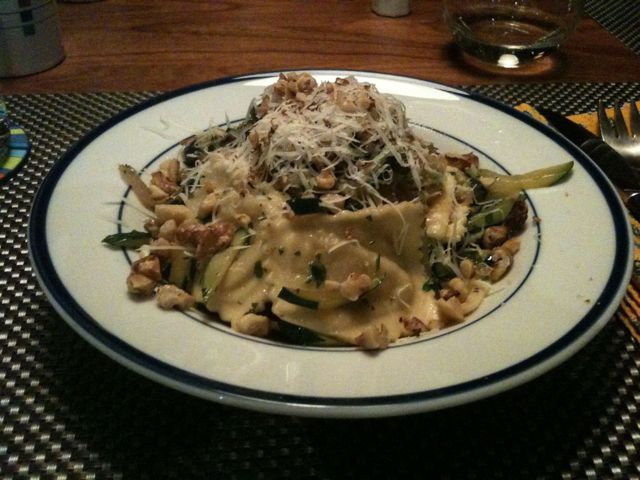
Ravioli with herbed zucchini and walnuts
Ben went to the Chelsea Market yesterday and bought some good ricotta cheese ravioli from Buon Italia. I wanted to make something fresh and light to accompany these good ravioli. I decided to use zucchini, and debated whether I should go bagna cauda style (olive oil, garlic and anchovy) or primavera style. The nice spring weather prompted me to go even simpler route using fresh herbs with the zucchini. So while the water for the ravioli is boiling, toast a handful of walnuts and saute some thinly sliced onion and garlic (I used 3 cloves) in generous amount of olive oil. When the onion and garlic are golden brown, add julienned zucchini. Meanwhile chop some parsley, thyme, oregano and/or mint (if you have them). Cook the ravioli. Add the herbs to the zucchini mixture. Continue sauteeing, and when the ravioli is cooked through, add the ravioli to the zucchini mixture with some pasta water. Gently mix them on the stove, serve it in a warmed pasta bowl (I rinse the bowl with the pasta cooking water to warm it. It makes a huge difference in preserving the hot temperature.) with the toasted walnuts, some grated parmesan cheese and a drizzle of good olive oil. Walnuts added meaty crunchiness that contrasted nicely with soft zucchini. We had it with a glass of very cold Portuguese vinho verde.
 Kira Nam Greene’s work explores female sexuality, desire and control through figure and food still-life paintings, surrounded by complex patterns. Imbuing the feminist legacies of Pattern and Decoration Movement with transnational, multicultural motifs, Greene creates colorful paintings that are unique combinations of realism and abstraction, employing diverse media such as oil, acrylic, gouache, watercolor and colored pencil. Combining Pop Art tropes and transnationalism, she also examines the politics of food through the depiction of brand name food products, or junk food. Recently, Greene started a figurative painting series spurred by the 2016 Presidential Election, Women’s March, #metoo movement and ensuing crisis of conscience, this new body of work aspires to present the power of collective action by women.
Kira Nam Greene’s work explores female sexuality, desire and control through figure and food still-life paintings, surrounded by complex patterns. Imbuing the feminist legacies of Pattern and Decoration Movement with transnational, multicultural motifs, Greene creates colorful paintings that are unique combinations of realism and abstraction, employing diverse media such as oil, acrylic, gouache, watercolor and colored pencil. Combining Pop Art tropes and transnationalism, she also examines the politics of food through the depiction of brand name food products, or junk food. Recently, Greene started a figurative painting series spurred by the 2016 Presidential Election, Women’s March, #metoo movement and ensuing crisis of conscience, this new body of work aspires to present the power of collective action by women.